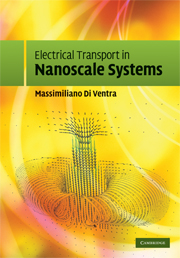Book contents
- Frontmatter
- Contents
- Preface
- 1 A primer on electron transport
- 2 Drude model, Kubo formalism and Boltzmann equation
- 3 Landauer approach
- 4 Non-equilibrium Green's function formalism
- 5 Noise
- 6 Electron-ion interaction
- 7 The micro-canonical picture of transport
- 8 Hydrodynamics of the electron liquid
- Appendices
- References
- Index
7 - The micro-canonical picture of transport
Published online by Cambridge University Press: 06 July 2010
- Frontmatter
- Contents
- Preface
- 1 A primer on electron transport
- 2 Drude model, Kubo formalism and Boltzmann equation
- 3 Landauer approach
- 4 Non-equilibrium Green's function formalism
- 5 Noise
- 6 Electron-ion interaction
- 7 The micro-canonical picture of transport
- 8 Hydrodynamics of the electron liquid
- Appendices
- References
- Index
Summary
So far, we have dealt mostly with the electron system already at an ideal steady state. We never questioned whether this state exists at all, and if so, how a many-body system does actually reach that steady state, whether the steady state we impose via single-particle scattering boundary conditions is actually what the electrons want to realize when they flow across a nanojunction, or even if it is unique.
In addition, we have mostly worked with electrons interacting at a mean- field level (see discussion in Sec. 4.2.4). We discussed in Chapter 4 how, in principle, one can introduce electron-electron interactions beyond mean field using the non-equilibrium Green's function formalism. However, except for simple model systems, it is computationally demanding – and most of the time, outright impossible – to use the interacting version of the NEGF practically in transport calculations (and not only in transport).
A simpler and more efficient way to treat electron-electron interactions in a transport problem would be thus desirable.
In this chapter I will introduce an alternative picture of transport – I will name it micro-canonical (Di Ventra and Todorov, 2004) – that does not rely on the approximations of the Landauer approach. In addition, this formulation does not require partitioning the system into leads and a central region, or assuming the leads contain non-interacting electrons in order to have a closed form for the current.
In fact, within this picture I will prove several theorems of dynamical density-functional theory (Appendices E, F and G) that, in principle, allow us to calculate the exact current – namely with all many-body effects included – within an effective single-particle picture.
- Type
- Chapter
- Information
- Electrical Transport in Nanoscale Systems , pp. 346 - 375Publisher: Cambridge University PressPrint publication year: 2008



